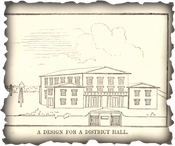PRINTED WORLD of CHARTISM
Chartist leaders, such as John Collins, were constantly in the public eye. Their activities were reported in newspapers throughout Britain and Ireland. And whereas conservative newsprint was not always favourable or fair to the Chartist Movement, the so-called "Chartist Press" made up for it.
Meetings, demonstrations, and reformers' speeches received in-depth coverage in newspapers such the Birmingham Journal, the Chartist, the Northern Star, and more. In the case of the Northern Star lithographs of the movement's most popular leaders - including John Collins - were offered to its readers.
Please click on the links below or use the drop-down menu on the Menu Bar to read the complete text of the following documents.
Meetings, demonstrations, and reformers' speeches received in-depth coverage in newspapers such the Birmingham Journal, the Chartist, the Northern Star, and more. In the case of the Northern Star lithographs of the movement's most popular leaders - including John Collins - were offered to its readers.
Please click on the links below or use the drop-down menu on the Menu Bar to read the complete text of the following documents.
WHAT IS A CHARTIST
This was a pamphlet answering the Question: What is A Chartist
This was a pamphlet answering the Question: What is A Chartist
THE PEOPLE'S CHARTER
The People's Charter took the form of a Bill that provided the basis for the Chartist Movement. Containing six main points for political reform, including Household Suffrage, the Charter became the rallying cry for the mass of working class people protesting against the inequalities of class legislation.
The People's Charter took the form of a Bill that provided the basis for the Chartist Movement. Containing six main points for political reform, including Household Suffrage, the Charter became the rallying cry for the mass of working class people protesting against the inequalities of class legislation.
THE NATIONAL PETITION
In February 1839 the General Convention of the Industrious Classes gathered in London. It was attended by dozens of delegates democratically elected to represent the political unions in towns and cities across the nation, including John Collins representing the people Birmingham. The purpose of the Convention was to organize and finalize the Birmingham-sponsored National Petition which was to be presented to Parliament in a show of solidarity for the principles of reform laid out in the People's Charter.
In February 1839 the General Convention of the Industrious Classes gathered in London. It was attended by dozens of delegates democratically elected to represent the political unions in towns and cities across the nation, including John Collins representing the people Birmingham. The purpose of the Convention was to organize and finalize the Birmingham-sponsored National Petition which was to be presented to Parliament in a show of solidarity for the principles of reform laid out in the People's Charter.
|
"Chartism - A New Organisation of the People" was an inspiring book written by William Lovett and John Collins during their imprisonment in Warwick Gaol.
"Chartism" proposed a National Association of the United Kingdom for the purpose of politically and socially improving the people. The book called for a national school system for children and adults including schools and halls; the establishment of libraries; and teacher training and missionaries. |
CHARTISTS PRAYER FOR COLLINS AND OTHER CHARTIST LEADERS
A prayer delivered at the opening of a Chartist church in London which referred to a much wished for time when the Chartist leaders including John Collins "shall shake the Senate House by their eloquence, and direct the realm by their wisdom ... ..."
A prayer delivered at the opening of a Chartist church in London which referred to a much wished for time when the Chartist leaders including John Collins "shall shake the Senate House by their eloquence, and direct the realm by their wisdom ... ..."
CHARTIST POEMS & SONGS
On his release from Warwick Gaol in July 1840, John Collins was greeted like a returning hero, and several poems/songs reflect that.
On his release from Warwick Gaol in July 1840, John Collins was greeted like a returning hero, and several poems/songs reflect that.
QUOTES & COMMENTS
From John Collins and the Chartist Movement.
From John Collins and the Chartist Movement.
Navigation Tips:
- Use the Menu Bar at top of each Page to follow the John Collins' story in chronological order.
- Go to the Content Page to browse all the Pages on the entire website.
- The Welcome Page gives an overview of the life and times of John Collins. I recommend you start there.
- The purple button will take you to the top of this Page.
Proudly powered by Weebly
